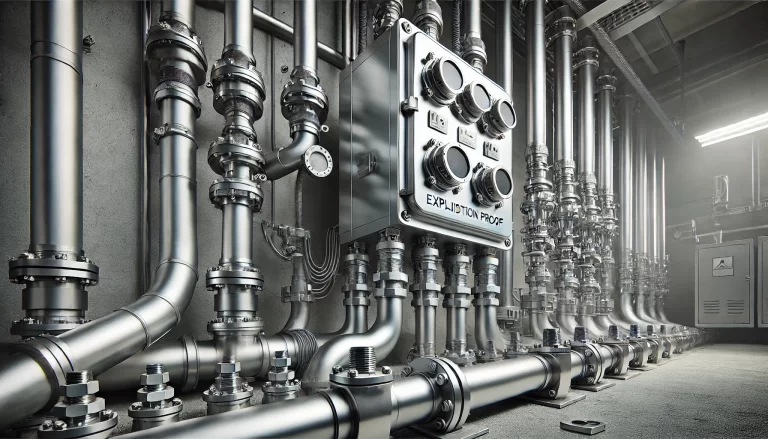With the latest round of safety inspections coming up, explosion-proof instruments remain a focal point. Ensuring that the instruments used in hazardous environments are genuinely explosion-proof is crucial for safety and compliance. In this article, we will walk through a comprehensive guide on how to verify the authenticity of an explosion-proof instrument.

1. Check the Product Label and Certificate
1.1 Explosion-Proof Marking
One of the easiest ways to identify an explosion-proof instrument is by checking the product’s outer casing for specific explosion-proof markings. These markings are regulated and should be clearly visible on the instrument. Common labels you may find include:
- Ex d IIB T4 Gb
- Ex db IIB T4 Gb (according to GB/T3836.1-2021 standards)
Each part of this marking gives specific details:
- Ex: Denotes the equipment is explosion-proof.
- d or db: Refers to the protection type, such as “flameproof” or “explosion-proof.”
- IIB: Indicates the group of gases the instrument is designed to handle.
- T4: Represents the temperature class, determining the temperature threshold the instrument can safely operate at without triggering an explosion.
- Gb: Indicates the protection level for gas atmospheres.
By cross-referencing these markings with the relevant standards, you can quickly determine whether the instrument meets the required explosion-proof standards.

1.2 Explosion-Proof Certification
Genuine explosion-proof instruments should always come with a valid explosion-proof certificate. You can verify the authenticity of this certificate by visiting the issuing authority’s website. Input the certificate number to check:
- Whether the certificate details match the information on the product.
- If the certificate is still valid, including the product’s manufacturing date and expiry period.
Some instruments may also feature additional certifications, such as the CCC certification for products included in China’s mandatory product certification list. Be sure to verify all certification details.
2. Inspect the Physical Appearance and Structure
2.1 Casing Material and Craftsmanship
Explosion-proof instruments often use high-strength, flame-resistant, and impact-resistant materials for their casings, such as aluminum alloys, stainless steel, or cast iron. Check the surface of the casing for:
- Cracks, pores, or defects that could compromise its strength.
- A smooth finish and tight connections. A well-made product is more likely to be truly explosion-proof.
It’s also essential to confirm that the casing has been processed without flaws that could allow dangerous gases or particles to seep into the instrument. These structural issues can severely affect the device’s protective capabilities.
2.2 Sealing Structure
A key feature of explosion-proof devices is their sealing structure. The seals must be robust and effective to prevent any explosive gases from entering the instrument. Check the following areas for proper sealing:
- The entry ports and cable glands (where wiring enters the device).
- The observation windows (if present).
- The sealing rings, gaskets, and any other sealing components.
Inspect the installation of these seals as well. Look for signs of aging, deformation, or poor installation, which could result in leakage, compromising the device’s explosion-proof performance.
2.3 Grounding Mechanisms
Instruments with metal casings should also have a proper grounding mechanism. Check for:
- Grounding marks on the external casing.
- Secure grounding bolts or screws.
- Proper grounding connections that comply with the industry’s standards.
A poor or absent grounding mechanism could lead to safety issues, especially in environments with volatile substances.

3. Understand the Product’s Source and Manufacturer Reputation
3.1 Purchase from Authorized Channels
Always purchase explosion-proof instruments through legitimate, authorized channels such as the manufacturer’s official website or accredited distributors. This reduces the risk of obtaining counterfeit or substandard products. Avoid buying from unofficial sources or unknown suppliers who may offer cheap, unverified alternatives.
3.2 Manufacturer Credentials and Reputation
It is vital to verify the manufacturer’s credentials. Ensure the manufacturer has the proper certifications to produce explosion-proof equipment. You can check:
- Whether the manufacturer is recognized and authorized to produce explosion-proof instruments.
- The company’s reputation within the industry. Look for customer reviews and feedback from credible sources.
- Check whether the manufacturer has any history of violations or substandard products.
Reputable manufacturers with strong industry standing are more likely to produce high-quality, reliable explosion-proof instruments.

4. Conduct Actual Testing (If Possible)
4.1 Gas Environment Testing
If safety allows and under controlled conditions, you may perform gas environment testing to verify the instrument’s explosion-proof capabilities. This involves placing the instrument in an environment with a controlled concentration of explosive gases. The instrument should be able to function properly without causing any ignition. However, this test is hazardous and should only be performed by trained professionals in certified facilities.
4.2 Electrical Performance Testing
Another method to test the explosion-proof functionality is through electrical performance tests. Use specialized equipment to measure:
- Insulation resistance: Ensure the device meets the required standards.
- Grounding resistance: Verify the grounding resistance is within the acceptable range.
These electrical tests help determine if the instrument’s electrical performance aligns with explosion-proof standards, ensuring it can safely operate in explosive environments.

Conclusion
In conclusion, verifying the authenticity of explosion-proof instruments involves multiple steps, including checking the product label, certification, physical structure, and testing where possible. Each of these steps plays a crucial role in ensuring that the instrument meets safety standards and is capable of performing in hazardous environments without posing a risk to personnel or equipment.
Remember, safety is paramount when working with explosive gases and volatile substances. Always take the necessary precautions and follow proper procedures to avoid accidents. If you have any further questions about explosion-proof instruments or safety measures, feel free to reach out and discuss.
